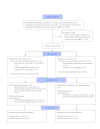A smartphone-based intervention with diaries and therapist-feedback to reduce catastrophizing and increase functioning in women with chronic widespread pain: randomized controlled trial
- PMID: 23291270
- PMCID: PMC3636250
- DOI: 10.2196/jmir.2249
A smartphone-based intervention with diaries and therapist-feedback to reduce catastrophizing and increase functioning in women with chronic widespread pain: randomized controlled trial
Abstract
Background: Internet-based interventions using cognitive behavioral approaches can be effective in promoting self-management of chronic pain conditions. Web-based programs delivered via smartphones are increasingly used to support the self-management of various health disorders, but research on smartphone interventions for persons with chronic pain is limited.
Objective: The aim of this trial was to study the efficacy of a 4-week smartphone-delivered intervention with written diaries and therapist feedback following an inpatient chronic pain rehabilitation program.
Methods: A total of 140 women with chronic widespread pain who participated in a 4-week inpatient rehabilitation program were randomized into 2 groups: with or without a smartphone intervention after the rehabilitation. The smartphone intervention consisted of 1 face-to-face session and 4 weeks of written communication via a smartphone. Participants received 3 smartphone diary entries daily to support their awareness of and reflection on pain-related thoughts, feelings, and activities. The registered diaries were immediately available to a therapist who submitted personalized written feedback daily based on cognitive behavioral principles. Both groups were given access to a noninteractive website after discharge to promote constructive self-management. Outcomes were measured with self-reported questionnaires. The primary outcome measure of catastrophizing was determined using the pain catastrophizing scale (score range 0-52). Secondary outcomes included acceptance of pain, emotional distress, functioning, and symptom levels.
Results: Of the 140 participants, 112 completed the study: 48 in the intervention group and 64 in the control group. Immediately after the intervention period, the intervention group reported less catastrophizing (mean 9.20, SD 5.85) than the control group (mean 15.71, SD 9.11, P<.001), yielding a large effect size (Cohen's d=0.87) for study completers. At 5-month follow-up, the between-group effect sizes remained moderate for catastrophizing (Cohen's d=0.74, P=.003), acceptance of pain (Cohen's d=0.54, P=.02), and functioning and symptom levels (Cohen's d=0.75, P=.001).
Conclusions: The results suggest that a smartphone-delivered intervention with diaries and personalized feedback can reduce catastrophizing and prevent increases in functional impairment and symptom levels in women with chronic widespread pain following inpatient rehabilitation.
Trial registration: Clinicaltrials.gov NCT01236209; http://www.clinicaltrials.gov/ct2/show/NCT01236209 (Archived by WebCite at http://www.webcitation.org/6DUejLpPY).
Conflict of interest statement
Conflicts of Interest: None declared.
Figures
Similar articles
-
A smartphone-based intervention with diaries and therapist feedback to reduce catastrophizing and increase functioning in women with chronic widespread pain. part 2: 11-month follow-up results of a randomized trial.J Med Internet Res. 2013 Mar 28;15(3):e72. doi: 10.2196/jmir.2442. J Med Internet Res. 2013. PMID: 23538392 Free PMC article. Clinical Trial.
-
Adherence to a smartphone application for weight loss compared to website and paper diary: pilot randomized controlled trial.J Med Internet Res. 2013 Apr 15;15(4):e32. doi: 10.2196/jmir.2283. J Med Internet Res. 2013. PMID: 23587561 Free PMC article. Clinical Trial.
-
Analyzing Change Processes Resulting from a Smartphone Maintenance Intervention Based on Acceptance and Commitment Therapy for Women with Chronic Widespread Pain.Int J Behav Med. 2017 Apr;24(2):215-229. doi: 10.1007/s12529-016-9590-7. Int J Behav Med. 2017. PMID: 27541314 Clinical Trial.
-
Web-based behavioral interventions for the management of chronic pain.Curr Rheumatol Rep. 2011 Dec;13(6):543-9. doi: 10.1007/s11926-011-0212-8. Curr Rheumatol Rep. 2011. PMID: 21913061 Review.
-
Are Positive Psychology Interventions Efficacious in Chronic Pain Treatment? A Systematic Review and Meta-Analysis of Randomized Controlled Trials.Pain Med. 2022 Jan 3;23(1):122-136. doi: 10.1093/pm/pnab247. Pain Med. 2022. PMID: 34347095
Cited by
-
Effective behavioral intervention strategies using mobile health applications for chronic disease management: a systematic review.BMC Med Inform Decis Mak. 2018 Feb 20;18(1):12. doi: 10.1186/s12911-018-0591-0. BMC Med Inform Decis Mak. 2018. PMID: 29458358 Free PMC article.
-
Smartphone Applications Designed to Improve Older People's Chronic Pain Management: An Integrated Systematic Review.Geriatrics (Basel). 2021 Apr 8;6(2):40. doi: 10.3390/geriatrics6020040. Geriatrics (Basel). 2021. PMID: 33917697 Free PMC article. Review.
-
Development and Pilot Evaluation of an Online Relapse-Prevention Program Based on Acceptance and Commitment Therapy for Chronic Pain Patients.JMIR Hum Factors. 2015 Jan 5;2(1):e1. doi: 10.2196/humanfactors.3302. JMIR Hum Factors. 2015. PMID: 27025550 Free PMC article.
-
Observational pilot study on the influence of an app-based self-management program on the quality of life of women with endometriosis.Arch Gynecol Obstet. 2024 Aug;310(2):1157-1170. doi: 10.1007/s00404-024-07468-4. Epub 2024 Jun 13. Arch Gynecol Obstet. 2024. PMID: 38869629 Free PMC article.
-
Utilization of telemedicine in conjunction with wearable devices for patients with chronic musculoskeletal pain: a randomized controlled clinical trial.Sci Rep. 2025 Jan 9;15(1):1396. doi: 10.1038/s41598-024-85056-x. Sci Rep. 2025. PMID: 39789122 Free PMC article. Clinical Trial.
References
-
- Croft P, Rigby AS, Boswell R, Schollum J, Silman A. The prevalence of chronic widespread pain in the general population. J Rheumatol. 1993 Apr;20(4):710–3. - PubMed
-
- Clauw DJ, Crofford LJ. Chronic widespread pain and fibromyalgia: what we know, and what we need to know. Best Pract Res Clin Rheumatol. 2003 Aug;17(4):685–701. - PubMed
-
- Shipley M. Chronic widespread pain and fibromyalgia syndrome. Medicine. 2010;38(4):202–204. doi: 10.1016/j.mpmed.2009.12.009. - DOI
-
- Lindell L, Bergman S, Petersson IF, Jacobsson LT, Herrström P. Prevalence of fibromyalgia and chronic widespread pain. Scand J Prim Health Care. 2000 Sep;18(3):149–53. - PubMed
Publication types
MeSH terms
Associated data
LinkOut - more resources
Full Text Sources
Other Literature Sources
Medical



